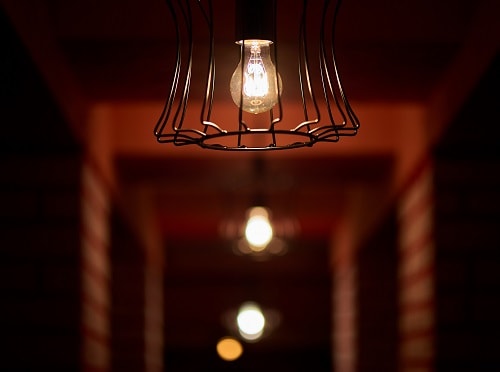♥ Sharing is caring ♥
DISCLAIMER: AS AN AMAZON ASSOCIATE I EARN FROM QUALIFYING PURCHASES. THIS POST CONTAINS AFFILIATE LINKS THAT WILL REWARD ME MONETARILY OR OTHERWISE WHEN YOU USE THEM TO MAKE QUALIFYING PURCHASES. FOR MORE INFORMATION, PLEASE READ MY EARNINGS DISCLAIMER.
As demand meets or exceeds the utility’s maximum output capacity, the utility has the option to reduce the supply of energy in particular locations, resulting in a brownout. During a brownout, electricity is supplied to your home or office, but at a lower voltage than normal. On the other hand, a blackout is a total loss of power.
While blackouts and brownouts are uncommon, learning what they are and how to react to them is critical to reducing the disruption of electrical service and potential damage to your electronics.
What is a blackout?
A blackout is a large-scale service disruption that may occur because of extreme weather or power plant equipment breakdown. It occurs when all electrical service is lost.
Blackouts occur without notice and continue for an indefinite amount of time. They sometimes happen because of a strong storm or an unlikely event. It is a total loss of power in a specific service area.
When our energy needs increase, so does the risk of suddenly losing the power supply. While state officials around the country are trying to upgrade the electric grid and expand power, it is still insufficient to satisfy demand when it is at its peak.
A blackout can be caused by a variety of factors. The following are some causes of blackouts:
- A surge in demand that exceeds the grid’s capacity.
- Damage to power lines or transformers.
- A storm that knocks out the electricity.
- Lightning bolts strike poles and interrupt power.
- Tree leaves strewn over power lines
- The accumulation of ice on power lines.
- Disturbance of overhead power lines
Difference between a blackout and power outage
Smaller interruptions caused by incidents like transformer malfunctions are often commonly referred to as “power outages,” as the word “blackout” typically applies to large-scale service interruptions.
Difference between a blackout and a rolling blackout
A blackout and a rolling blackout are two different situations. Rolling blackouts are normally scheduled service interruptions that occur with advance notice. They usually last a certain amount of time and are intentionally generated by energy providers to deal with peak power demands.
Rolling blackouts are generally expected to affect only a single coverage area, and the electricity supplier will distribute these blackouts around many service areas to ensure that no one area loses much more than another.
Rolling blackouts are often scattered around many locations for a short period of time, preventing larger-scale blackouts. They are usually announced by utilities, but there is a possibility that you can miss the announcement.
Difference between a rolling blackout and a planned power outage
When a power provider does service work in a specific location, a scheduled outage is usually reported in advance, on the other hand, a rolling blackout occurs with no notice and is meant to ease the load on grid.
What is a brownout?
Brownouts are induced by high power demand that is close to or exceeds a utility’s capacity. In order to avoid a blackout, this way, the utility can minimize the flow of electricity to some areas.
 It’s a traditional emergency technique used by energy providers to save the grid from experiencing a blackout. The word “brownout” refers to the dimming of lights caused by voltage fluctuations.
It’s a traditional emergency technique used by energy providers to save the grid from experiencing a blackout. The word “brownout” refers to the dimming of lights caused by voltage fluctuations.
A utility could reduce overall system voltage by 10-25 percent for a limited period of time during a brownout to ease the strain on the system. Although, this type of power reduction has no effect on heat or lights, it can have an influence on electrical equipment that is more vulnerable to precise voltages.
Long-term brownouts may induce premature wear in non-electronic equipment, and sensitive electronic devices (that need relatively specific voltages) will not be able to work at all.
If this type of undervoltage happens, computer systems will have problems, and electric motors will run hotter than usual (since they are needed to achieve the same horsepower during a brownout as they would during a normal operational situation).
Brownouts can also trigger a motor to run in a reverse direction. A brownout is a voltage reduction in an electrical power supply system that is either deliberate or accidental.
Brownouts can also arise randomly as a result of disruption or failure inside the grid or a local power plant, but this is much less frequent. In short, a brownout is a partial reduction of system voltage or overall system power.
During an emergency, intentional brownouts are used to reduce load. Electric utilities deliberately create brownouts (similar to rolling blackouts), to help temporarily relieve the pressure on an overburdened power grid.
Difference between a brownout and voltage sag
Brownouts are different from normal voltage fluctuations. Brownouts, as opposed to short-term voltage sags, last minutes or hours.
In certain service areas, system voltage can differ by up to 5% above or below “nominal” line voltage. Therefore most consumer and industrial goods in North America are engineered to operate normally and reliably over extended periods of time at voltages ranging from 115 to 125 volts.
Difference between a blackout and brownout
The most significant distinction between blackouts and brownouts is that blackouts are total power outages, while brownouts are partial outages.
Other than the electricity being turned off entirely, the voltage is normally decreased. Brownouts are intermittent reductions in overall grid capability, while blackouts are full power outages.
The utility is aware of when the brownout will begin and finish. Blackouts occur as a result of grid overload or an accident.
Here is a short summary:
| Blackout | Brownout |
| No power | Low power |
| By accident * |
By design ** |
| Unexpected duration * |
Known duration ** |
* They could be planned (like rolling blackouts), but that is not common.
** Ask your local utility how long they plan to keep it going…
This is how blackouts work:
![]()
They are quite different and the only similarity between them is the inconvenience that they cause us!
What do to during a blackout?
If you do not have a whole-house surge protector, you can unplug your most sensitive (to electrical fluctuations) devices after the power is cut off. They will not be affected during the blackout, but there will be a brief surge when the power is returned, which may cause damage to your electronic equipment and some appliances.
When you have a chance, contact the local utility to notify them of failure and ask about service restoration. A romantic candlelight dinner is a good option as well…
What do to during a brownout?
The first thing you can do if you find out that your lights are dimming or other signs in your home that are associated with a brownout, is NOT to panic!
 Simply unplug all computers and other sensitive, and most vulnerable electronic devices. Low voltage levels won’t harm any of the household appliances, but electronics can get damaged.
Simply unplug all computers and other sensitive, and most vulnerable electronic devices. Low voltage levels won’t harm any of the household appliances, but electronics can get damaged.
The second step you can do (after disconnecting your devices) is to contact the local utility to ensure that the brownout is caused by the grid itself. The reason for this is that the brownout you are experiencing could be the result of an electrical issue in your own house.
In this case, for immediate assistance, contact an electrician. If you wish to be alerted to all scheduled and unplanned brownouts and blackouts, consult with the power company and see if they offer text or email warnings.
Signing up with these updates is also the simplest way to keep updated on improvements to the electrical grid that can concern you.
Protecting expensive shop equipment
Brownouts and power outages trigger under-voltage, which has costly consequences such as increased motor failures and decreased output. Monitoring the supply of voltage and teaching staff to act immediately if it falls below a predetermined threshold are two basic precautions to keep your equipment safe.
You can install thermal protectors or condition-monitoring systems for sensitive applications that can sense abnormally high winding temperatures and shut down the engine. Reduce the load by throttling back a fan or partly closing a valve during a brownout if shutting down isn’t a choice that you can make.
Here is one good tool used on the market right now:
![]()
Don’t forget that you might be setting yourself up for major issues if you don’t take constructive measures. The windings of a motor will be damaged if it is turned on and off too fast. Using a holding coil to stop the motor isn’t the best choice because the result is similar to starting a motor at 112 times rated voltage.
All electronic devices and electric motors can now be operated more precisely thanks to computers. They can start the motor, check the power quality, and react the way an expert operator will – every single time! Rather than guessing whether the voltage is down or unbalanced, the controller recognizes the problem and takes care of it.
So, how do you prepare for this type of event?
UPS (Uninterrupted Power Supply), Solar Panels, Batteries, and inverters are all at your service!

Click on the white button above to find your electrician!





